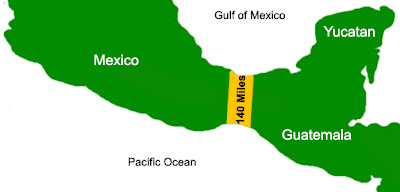Why do we know this? Because Mormon tells us. And in accepting Mormon’s view and explanation as written, because we know it to be true, we satisfy the first rule of discovery—“Accept nothing as true which you do not clearly recognize to be so.”
In Descartes second rule of discovery, “Divide up each of the difficulties examined into as many parts as possible,” we need to divided, or list, all of the separate parts of Mormon’s description of the Narrow Neck of Land:
1. It is narrow (Webster: “Having little distance from side to side”)—a regular man could walk across it in a day and a half (Alma 22:32). How far could an average person cover in a day? First, It depends on how fast the person is walking, the road he is walking on, how much stamina the person has to maintain a walking gait, and a number of other factors. But since Mormon was using such a measurement tool to indicate to us how wide the narrow neck of land was, we might assume average factors.
Studies have shown that the average human walking speed is about 3.1 miles per hour or about 20 minutes per mile, taking an average stride length of 2.5 feet (30 inches), or about 10,000 steps in five miles. More specific studies have found pedestrian walking speeds ranging from 2.8 mph to 2.95 mph for older individuals, to 3.3 mph to 3.37 mph for younger individuals.
 Statistically, a person walking for fifteen straight hours could cover as much as 30 to 40 miles, factoring in fitness and terrain, though a person would slowly decrease in speed as time passed. However, walking without breaks, eating, drinking, etc., would generally render an individual incapable of going further. Since ancient times, walking for twenty miles in a day is a good rule of thumb. Although a recent algorithm created by a computer “nerd” showed that 25 miles per day would be accurate.
Statistically, a person walking for fifteen straight hours could cover as much as 30 to 40 miles, factoring in fitness and terrain, though a person would slowly decrease in speed as time passed. However, walking without breaks, eating, drinking, etc., would generally render an individual incapable of going further. Since ancient times, walking for twenty miles in a day is a good rule of thumb. Although a recent algorithm created by a computer “nerd” showed that 25 miles per day would be accurate.Thus, the average person could probably cover a distance of about 30-37.5 miles in a day and a half covering comparatively level ground. This should suggest, that Mormon in describing a Nephite (basically a city/rural person) and not a Lamanite (a hunter/gather person), was describing an average man.
2. It is a neck (Webster: “A narrow track of land between two larger tracts”)—It lay north of Bountiful and south of Desolation (Alma 22:31-32)—that is, the narrow neck was located between the two major lands (Land Southward and the Land Northward).
3. It is an area of land (Webster: “The ground”). It was a solid area between to seas, separating the two major land masses.
4. It has a sea on both sides (Webster: “The ocean; a branch of the ocean”)—It had the West Sea on one side (Alma 63:5), and the East Sea on the other side (Alma 50:34)
5. It was a means of travel between the two major land masses (Alma 50:34; Mormon 2:29)
6. It was narrow enough to be defended and the only means of travel between the two land masses (Alma 22:33; Mormon 2:29)
Using Descartes Rules of Discovery, we find that the Narrow Neck of Land described by Mormon, ran north and south, was about 30-40 miles wide, had a narrow pass or passage through it, separated two larger land masses, had seas on both sides, could be easily defended, and was the only ingress or egress between the Land Southward and the Land Northward.
Thus we can conclude that there is no topography now or in the past that matches Mormon’s description of a narrow neck in either the Great Lakes (Eastern U.S./ heartland) or Mesoamerica.
 But one can be found in the area of the Bay of Guayaquil bordering Ecuador and Peru in the Andean area of South America as clearly outlined in the book “Lehi Never Saw Mesoamerica.”
But one can be found in the area of the Bay of Guayaquil bordering Ecuador and Peru in the Andean area of South America as clearly outlined in the book “Lehi Never Saw Mesoamerica.”And, certainly, John Sorenson’s introduction of marathon runners, special Indian runners, and other athletic anomalies not only is inconsistent with Mormon’s description and intent, but violates Descartes Rules of Discovery by introducing the complex over the simple, and adds nothing to the investigation into the location of the Land of Promise.




No comments:
Post a Comment